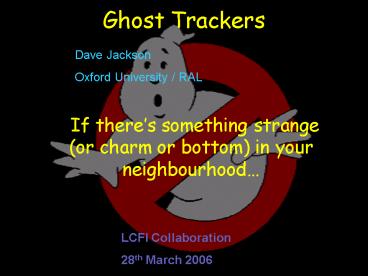Ghost Trackers - PowerPoint PPT Presentation
1 / 16
Title:
Ghost Trackers
Description:
In the Ghost Track algorithm the straight' IP- B- D topology is exploited first, ... The straight ghost track is anchored at the IP, initially given a 25 m width ... – PowerPoint PPT presentation
Number of Views:118
Avg rating:3.0/5.0
Title: Ghost Trackers
1
Ghost Trackers
Dave Jackson Oxford University / RAL
- If theres something strange (or charm or
bottom) in your neighbourhood
LCFI Collaboration 28th March 2006
2
ZVRES
ZVKIN
In the conventional ZVTOP algorithm secondary
vertices are found first. The linearity of the
B-D decay chain is then used for L/D track
attachment
In the Ghost Track algorithm the straight
IP-B-D topology is exploited first, to estimate
the B/D flight direction before vertex finding
3
The straight ghost track is anchored at the IP,
initially given a 25µm width then moved in ? and
f to minimise ? ?2 (sum over jet tracks). Final
fitted width of ghost track (minimum 25µm)
calculated for compatibility with jet tracks
each has ?2 1.0 with fitted ghost track
SLD
4
The SLD Ghost Track used straight Gaussian tubes
for fast analytic track fits this required
reparametrising the track near a vertex
location. This should not be so much of an issue
for the LCFI C code in which the approximation
is not made
5
Care with errors and ?2s important since vertex
finding relies on probability of vertex fit
calculation
SLD
PROB(??2,2N-3) For N tracks in jet from same MC B
vertex (spike at zero due to non-Gaussian tails)
PROB(??2,2N-4) Where N now includes the Ghost
Track in the fit so less free than the jet
tracks alone. Probability is now a measure of a
good secondary vertex fit AND compatibility with
the B direction (ghost track).
6
SLD
The algorithm proceeds to build vertices
according to the highest Probability while
Prob1. So this distribution needs to be fairly
flat for genuine vertices and to be flat for a
range of track multiplicity (shown here), decay
length, etc. The pre-requisite for this is a
fitter that has the right properties for jet
tracks alone.
Probability of ghost B tracks fit
7
At SLD the Bs came in back-to-back pairs. The
EVENT would be tagged with ZVRES before running
ZVKIN for analysis of each jet
For LCFI generally would like to consider each
jet independently design flavour/charge tagger
for each jet with ZVTOP3 in C
SLD
8
BACKUP SLIDES
9
L/D for non-Seed tracks passing T Cut at L/D 0.3 to attach tracks from B decay
chain to Seed
10
- Highly boosted B kinematics IP?B?D straight to
1 (for Z0) - B,D vertex locations are not independent in 3D
space - Ghost Track Algorithm builds in this
information from the beginning
11
- Stage 1
- Pivot straight ghost track at IP, initially
along jet axis direction - Give ghost track a 25µm width and calculate ?2
of ghost to each track in jet - Swivel ghost track in ? and f to minimise ? ?2
(sum over jet tracks)
12
- Stage 2
- PROB(?2,ndof) for jet track(s) to be consistent
with each other and with the ghost track or IP
ellipsoid is constructed - For jet with N tracks, initially N1 candidate
vertices
1
2
N1
Ghost
IP
3
- Calculate fit probability for all pairs of
objects (if IP is not included, then ghost track
is added) - If maximim PROB PCUT (typically 1) then
combine the two objects and iterate - Else vertex reconstruction is complete
N
PRI
SEC
TER
Allows reconstruction of 1-prong vertices
13
The Topologies
For a B decay to a single cascade charm
D
lD
B
lB
IP
Measured lB
Measured lD
True MC lB
True MC lD
cm
cm
14
Compare ZVTOP with Ghost Track Algorithm
ZVTOP
GHOST
Number of Found Vertices
ZVTOP
GHOST
GeV/c2
B Decay Invariant Mass
15
Options
- The Tidy cuts
- For SLD 20 of jets contained 1 high impact
parameter track from Ks, ?, detector interaction
etc. - Tidy cuts are applied first to prevent the Ghost
Track direction being distorted (half background
tracks removed at SLD) - For each algorithm 4 tunable parameters that
effect efficiency vrs purity of vertex
reconstruction - also
- ZVTOP can guide vertex finding with V(r)
weighting - Ghost Track
can
force the topology to find fixed number of
vertices Momentum factor
16
World BS mixing sensitivity
B0 b?c D or D0
July 2003































